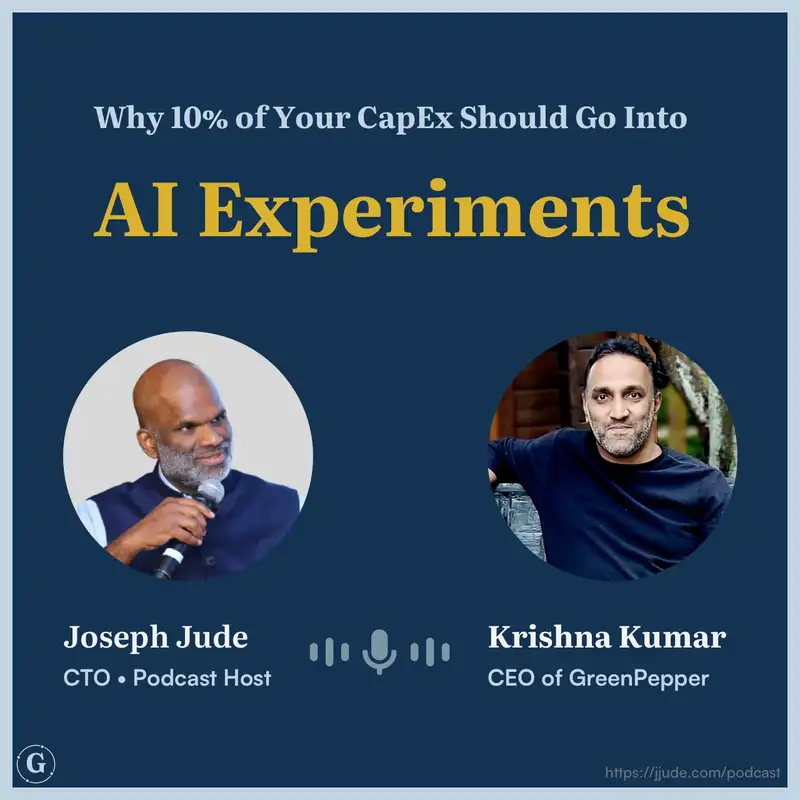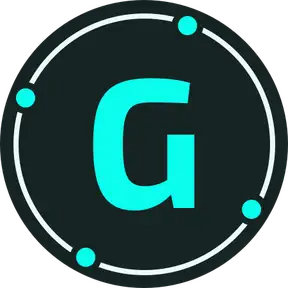E103: 'Optionality Bets with Generative AI' with Krishna Kumar
**Joseph Jude:** Hello and welcome to Gravitas WINS Conversations. I'm your host, Joseph Jude. Jeff Bezos says, "==Winners pay for many experiments==." With generative AI, ==the cost of trying bold ideas has dramatically dropped==. Small teams can ship quicker and learn faster.
My guest today says you should put 10 percent of your CapEx into optionality bets. We're going to discuss what kinds of bets are worth making, how to spot winners, and how leaders can build a culture of smart experimentation.
My guest, Krishna Kumar, is not new to the podcast. I spoke with him earlier in episode number 96 about [[Krishnakumar on 'Solve and scale with Generative AI']]. I highly recommend you check that out. He's back on the podcast after a year. In that time, he has written a book, _[The GenAI War Room](https://kkaction.gumroad.com/l/GenAIWarRoom)_, drawing from his vast experience coaching over 30,000 professionals and facilitating more than 140 AI workshops.
Before we get into the interview, can I request you to subscribe to the podcast, write a review, and share it with your fellow business leaders?
Hello KK, welcome to the conversation.
**Krishna Kumar:** Good to be back, Joseph. I've been observing you over the last year. Interesting and great progress.
**Joseph Jude:** Let's start with this. When you say 10 percent on optionality bets, what do you mean by that? What are these optionality bets? Why 10 percent? Walk me through that.
**Krishna Kumar:** ==Enterprises often feel risk management is more important than experimentation, and that's where innovation slows or stops==. They try to understand and control every bit of risk, which suppresses creativity.
Rather than building a rigid AI strategy, it's better to experiment with it. Many companies are still using pre-AI mental models—project planning, digital transformation strategies. But AI is a different canvas. It's growing 25 times faster than any other technology we've seen. So our approach as leaders must change accordingly.
Another reason for optionality bets: we can't learn everything upfront. The only way to learn is by doing. Even enthusiastic, curious teams can't keep up with everything. Most enterprises don't have that luxury. Optionality bets give us a language and a strategy to stay relevant. ==It's a small price to pay to avoid becoming irrelevant==.
**Joseph Jude:** KK, we'll get into the types of experiments soon, but these require funding. How can business leaders, especially CTOs, CEOs, and CMOs, convince their CFOs or boards to fund these smart bets? What kind of proposal can be presented?
**Krishna Kumar:** One big advantage now is that the cost of experimentation has dropped drastically. As you said earlier, it's affordable failure. Previously, a digital transformation project worth $5 million couldn’t fail. But now, we can run smaller experiments at lower risk.
Hiring AI talent—builders, researchers—is 10x more expensive than just doing some smart experiments. So leaders can present these experiments as a more cost-effective alternative. Use tools like ChatGPT’s GPT-4 to build a case. Treat it like a personal strategist: ask it to generate a slide deck or pitch for your skeptical CFO. It delivers sharp, personalized narratives and data. ==This is applied intelligence—affordable and deployable==.
**Joseph Jude:** One beauty of this technology is that you can use AI to understand AI. You can even build a case for AI using AI.
KK, you run workshops, coach professionals and companies. What kind of experiments are we talking about? Can you share examples of what marketing, tech, and sales teams are doing? Not just asking ChatGPT for a sales pitch, but actual structured experiments.
**Krishna Kumar:** Most enterprises I talk to get excited about the productivity potential of AI. They see it's not just a tool—it’s a wide canvas. During enterprise workshops, we ==explore use cases and tools==. Teams then ==pick what’s most relevant== and deployable.
For example, a recent bank workshop felt like a war room. The Chief Operating Officer attended the full day. We generated 60 use cases across credit, sales, marketing, operations, and strategy. We shortlisted 15, then deployed 3 immediately—all internal tools.
These included knowledge management systems, regulatory compliance workflows, and internal productivity tools. AI made it easier to solve contextual, complex problems. Employees no longer needed to ask around—they could query the system and get useful, step-by-step answers in minutes.
The ROI? Problem-solving time dropped from two hours to ten minutes. Accuracy, judgment, and creativity improved. Scale improved—==AI could solve problems for 10,000 people simultaneously==. For example, sales teams using AI voice agents could handle queries on 200 products with natural, empathetic tone—better than most humans.
Young users are comfortable with AI agents. The entire call is documented, retrieved next time, and context is preserved. Service becomes more consistent, more equal, more scalable.
**Joseph Jude:** That’s insightful. You said something powerful: ==AI democratizes customer service. It treats everyone equally, not just based on wealth==.
You also said AI is not just a tool, but a canvas. Can you elaborate?
**Krishna Kumar:** A tool performs a fixed task. But LLMs like ChatGPT are shaped by our imagination. There’s no manual. It’s like the alphabet—you can create literature, technical documents, anything.
==AI is a cognitive revolution==. It’s not just tech—it ==augments your thinking==. With it, your ideas develop faster, better. It’s your assistant, analyst, visualizer.
**Joseph Jude:** Let's talk about your book. You mention a "Six Bucket Framework." What is it, and how can companies use it?
**Krishna Kumar:** Companies needed a structure to identify AI use cases. The Six Bucket Framework helps them organize where AI can help. It's not a perfect structure, but it works for 80% of companies.
Here are the ==six buckets==:
1. **Time** – Tasks that consume too much time. AI can reduce a 6-hour task to 30 minutes.
2. **Effort** – Tasks employees dislike. AI can relieve repetitive or tedious work.
3. **Accuracy** – Tasks needing precision. AI reduces human error, especially in resume screening or credit analysis.
4. **Judgment** – Areas where human bias creeps in. AI can follow consistent, predefined criteria.
5. **Creativity** – Not everyone is creative, but AI can boost creative output.
6. **Scalability** – AI helps small teams do work that previously needed large headcount.
The old model said, "To grow, hire more." The new model says, "To grow, use AI to scale." It’s a shift in thinking.
**Joseph Jude:** It changes the operating paradigm. A smaller team can now serve larger demand using AI agents. What team structure works best for this?
**Krishna Kumar:** Small and mid-sized teams have agility. They can move fast, avoid bureaucracy. Leaders need to act like war room commanders, not COE managers. A COE is slow and thought-heavy. AI needs urgency.
==War rooms create focus, urgency, and attention==. It’s not a side project. ==If you treat GenAI as a side-project, it will be sidelined.== Leaders must take ownership and pride. Good leaders take AI personally—they want to be relevant, they want their teams to succeed.
**Joseph Jude:** From everything you’ve said, it’s clear: humans still matter. ==AI augments us, it doesn’t replace us==.
**Krishna Kumar:** Absolutely. AI isn’t accountable—humans are. Leaders still need critical thinking, storytelling, trust-building. AI lets us take on more, but we remain responsible.
**Joseph Jude:** What’s one experiment you’re personally excited about in the next six months?
**Krishna Kumar:** An ==AI-first university.== A place where everything is learned with and through AI. Like kids picking up an iPad—AI learning will feel natural soon. Structured credentials won’t matter as much. AI makes learning accessible and structural-less.
**Joseph Jude:** I relate to that as a homeschooling dad. My sons use ChatGPT to explore complex ideas and write essays—on mimetic theory, hedgehog and fox models, and more. I can visualize what you're building.
**Joseph Jude:** What kind of workshops do you offer, and how can people connect with you?
**Krishna Kumar:** Over the last year, I've run various formats. What works best:
- **Mental Models for Leaders** – They don’t need the tech. They need frameworks.
- **Use Cases** – Real tools solving real problems.
- **Live Kitchen** – We solve live problems. Sometimes it fails. That’s okay. Failure is affordable.
- **Verticalized Programs** – For HR, doctors, designers, legal, etc.
- **Enterprise Workflows** – Build AI-native workflows.
- **GenAI War Room** – 90-day pilot, cross-functional teams, serious execution.
**Joseph Jude:** You also wrote a book. How did you use GPT to write it?
**Krishna Kumar:** I wrote every day. After each workshop, I noted insights. Then used GPT to expand my points. GPT-4 helped me think in different roles—strategist, CFO, analyst.
The ideas are mine. Frameworks are mine. GPT was my collaborator. It helped sharpen and structure my thinking. I’ve acknowledged that clearly in the book.
**Joseph Jude:** Thank you, KK. Talking to you is always insightful. You’re a practicing philosopher—you experiment, reflect, and then share. It’s a pleasure having you.
**Krishna Kumar:** Thank you, Joseph. Always a pleasure to be here.
**Joseph Jude:** I hope you’ve enjoyed our conversation. Please share your key takeaways, subscribe to the podcast, and share it with others. Live a life of wins.
Creators and Guests


